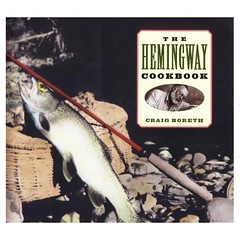I recently had the opportunity to interview Craig Boreth, author of The Hemingway Cookbook. Here's a bit of our discussion...
When I first traveled to France and Spain about ten years ago, I thought following a Hemingway itinerary -- from his Paris haunts, through San Sebastian and Pamplona and down to Madrid -- would be a great way to really dig into the terrain. Of course, while doing so I found myself bar- and restaurant-hopping all day and night, and I began to realize that Hemingway wrote often (and, in my opinion, brilliantly) about food, and the idea of a cookbook began to take shape.
You interview a lot of people who knew and worked with "Papa." Was it hard getting people to talk with you? Did anyone turn you down? Who were some of the most interesting characters you met?
The greatest character I met was definitely Forrest "Duke" MacMullen, a hunting buddy of Hemingway's from the Idaho days who provided the recipe for Cornish Pasties. He loved talking about those old days, and his letters always smelled of pipe smoke.
Of all the people I spoke with, I only had one bad experience. I called a rather famous photographer to inquire about buying the rights to use a photo of Hemingway. I don't know if he was off his meds that day, but when I told him that $10,000 was way beyond my budget, he told me to "stop playing games and call back with a real offer," and he hung up on me.
What's your favorite recipe from the book?
My favorite is the lime ice with gin and crème de menthe. Having visited Hemingway's home in Cuba in summertime, I can imagine how this refreshing dessert could cut through the sweltering heat. It's really easy to make, it's got a great fresh lime tartness and a nice kick of booze.
Craig gracefully gave us permission to share this recipe with you here...
Lime Ice This dessert, clean and tart with just enough kick, is the perfect refreshment on a hot July afternoon in the hills just outside of Havana. 4 to 6 servings
1 1/2 C sugar syrup (see below)
Juice of 6 limes
1/2 T lemon juice
1 C water
1 egg white
3 1/2 tablespoon gin
2 T crème de menthe
Rind of 1/2 lime, very finely chopped (optional)
Remove the rind of half of 1 lime and cover with plastic wrap. Combine the juice of the 6 limes, lemon juice, sugar syrup, water, and egg white in a large-bottomed, sturdy plastic container, so that the liquid is no more than 2 inches deep. Stir the mixture completely. Cover and place in the freezer for 1 1/2- 2 hours. When ice has formed around the edge of the mixture and the center is slushy, blend fro a few seconds with a hand mixer or whisk. Cover and return to the freezer for another 1 1/2 hours or so. Repeat process, adding the gin, crème de menthe, and minced lime rind after the third freezing.
Return the mixture to the freezer for another 30-60 minutes, or until firmly frozen. The ice may be served directly from the freezer, as it will stay somewhat soft and scoopable with the alcohol included.
How did you go about testing the recipes? Did you personally make all of them?
I've prepared most of them myself, but I enlisted many friends to help test them all.
Some of them are a bit out there, for example, did you try the "Mount Everest Special," a sandwich of white bread, peanut butter, and onions!?!
That's one of the things that makes the book so interesting. It's a (hopefully) very accurate representation of Hemingway's culinary biography. He had a huge personality and an appetite to match, and the recipes in the book reflect them.
What's the most surprising thing you learned about Hemingway in the process of researching and writing the book?
I was surprised to learn how sophisticated Hemingway was in his use of food within his stories. I assumed it would all be boozing and gluttony. As an artist, he didn't just use food symbolically in his writing, but he also brought in his expertise to make sure that the foods were local, in season, and perfectly-suited to the character in that particular time and place. It's a deliberate and painstaking process that adds depth and richness to what is often mistaken for being sparse prose.












Comments
March 12, 2008
The photographer probably now wishes he hadn't hung up the phone. So many yummy recipes. I'm afraid I read them then lose them because I forget them like this lime one - so perfect for a hot summer day in the country. BUT reading your blog is like going to bed with a favorite cookbook to leaf through before you fall asleep.
March 12, 2008
Thank you for this interview. I've enjoyed reading most of this book and found it a wonderful way to spend and afternoon. Thanks too, for the part about the Mt. Everest Sandwich....hmmmm, maybe I'll have to try it, just to find out how it tastes.
August 22, 2008
This is an excellent book, as well as excellent cookbook. Moreover, it is a sublime addition to anyone's
Papa collection. I find myself immersed in it, even when I have no intention of cooking anything. You do Hemingway proud, Mr. Boreth.